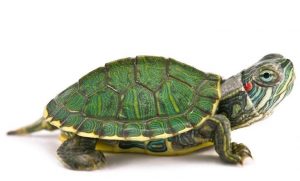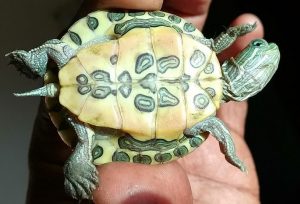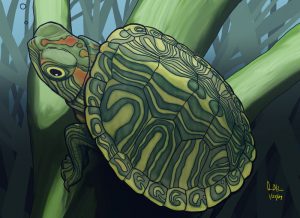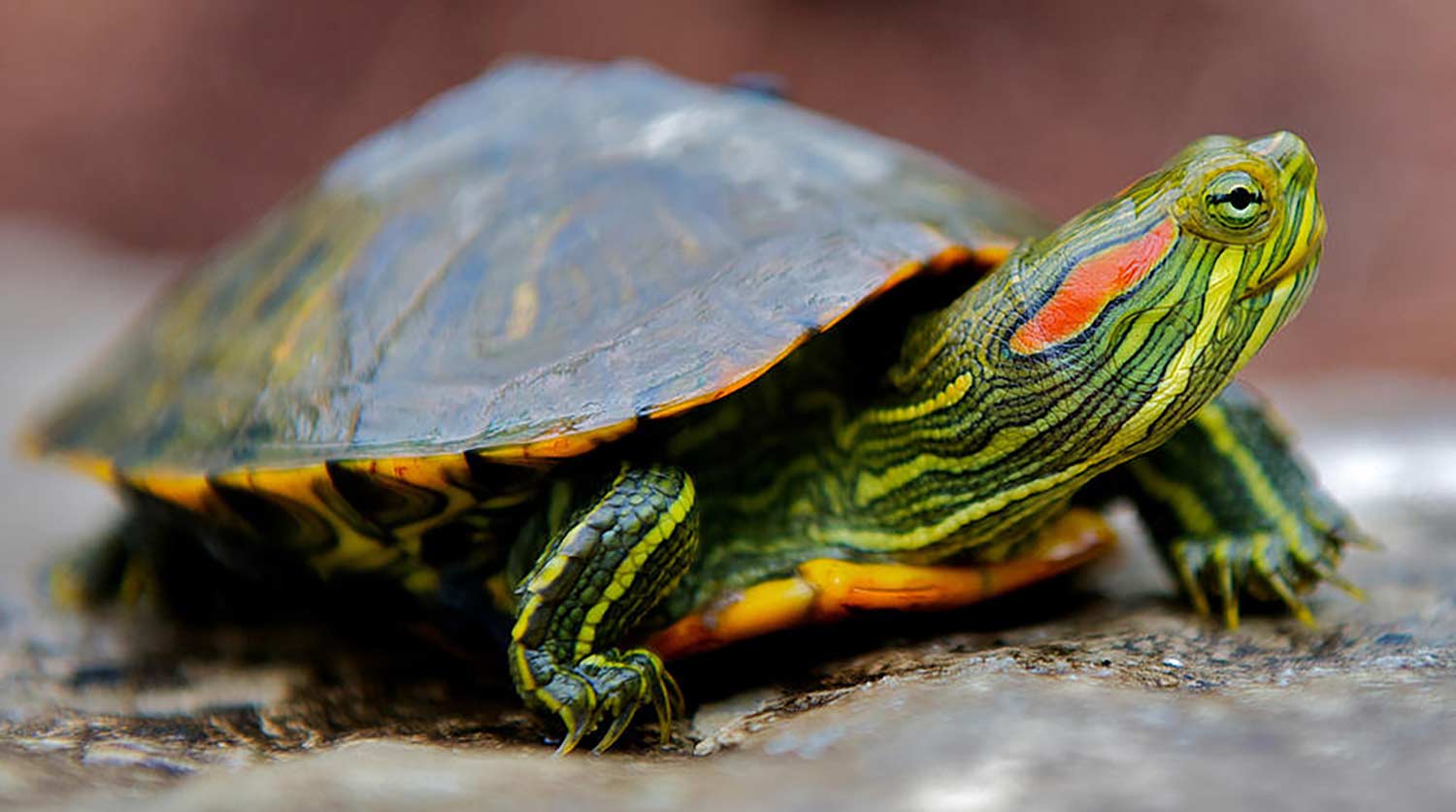When one species is much adapted than the others, they start dominating the entire ecosystem and once people recognize it, people tag them with the name ‘Invasive’. The red-eared Slider or red-eared terrapin (Trachemys scripta) is one such species that have the bad reputation as an ‘Invasive’ species to the country. Their origin is from America and they are a visitor species to Sri Lanka. This make them designated as an Invasive alien species. They grow rapidly, compete vigorously and in the absence of their natural predators, push out native species and alter ecosystems, causing damages to the environment, human health, livelihoods and economy (IUCN, 2005).
Terrapins are the chelonians that owns intermediate characters of turtles and tortoises. Like turtles, they own a flat and smooth carapace to reduce pressure drag in swimming, but lack flippers. Like tortoises, they have clawed limbs and they are modified as webbed feet that aid them in both walking on land and water. Terrapins are also known as freshwater turtles.

Red-eared sliders are fancy creatures with elegant color patterns that make them adorable pets all over the world. The distinct yellow and green stripes on head, neck and limbs make them characterized. Prominent red stripe that lies on the location that its ear would be gives them their name, Red ear. The slider name comes as they could slide through the water with making no ripples.

Red-eared sliders start their life as tiny shelled hatchling from the size of a two rupee coin and grow up to big and bigger up to 10 inches long. Their entire body is designed with stripes and patterns which make it much elegant than the others. Yellow plastron has green circular patterns on each scute and the carapace is yellowish green in color with yellow stripe patterns.

These fancy creatures have the crucial ability to withstand to naive environmental conditions and this lead them to be invasive. It is predicted that Red-eared sliders have either escaped from the aquariums or are carelessly released to the wild by irresponsible pet-owners. The reason behind the ignorant releasing is that the pet-owners lose their interest towards this amphibious pet as it grow bigger and older. Adult males growing older gets darker and females become paler than their young stage which make them less attractive.
Although natural barriers such as oceans, mountains and rivers, facilitate species and ecosystems to evolve in isolation, such barriers have failed with globalization, where trade, transport, travel and tourism have accelerated the species movement through the barriers (Silva¹, P., & Kurukulasuriya, M. (2010). Red-eared Slider (Trachemys scripta)) is a carnivorous turtle that can pose a serious threat to native aquatic vertebrate fauna (Bambaradeniya, C. N. (2002)). Studies conducted in other countries have shown that they have become a threat to native terrapins where they compete for food, basking sites and breeding places.
These aliens become better survivors in any naïve environment due to their much adaptability. Broad ecological tolerances, omnivorous diet, and dispersal ability, there is the potential for establishing breeding populations in many areas of the world but little research has been carried out yet. (Ramsay, N. F., Ng, P. K. A., O’Riordan, R. M., & Chou, L. M. (2007)). It is also found that these have a higher reproductive success, whether these could lay up to a dozen eggs twice a year.
These also can act as vehicles for alien infections which effect on both flora and fauna. Aquaculture of Red-eared Sliders for the pet trade are often associated with the threat of salmonellosis in children who receive them as pets (Williams, 1999), but it could negatively impact indigenous wild turtles when released pets spread diseases and parasites into the environment (Stuart, 2000).
Because of these notorious behavior of Red-eared slider, several Asian countries have now banned the importation of red-eared sliders and/or have attempted to restrict the trade in wild species (Ramsay, N. F., Ng, P. K. A., O’Riordan, R. M., & Chou, L. M. (2007)).
Even though the importation of these animals have been started by 90s, it is strange that any proper study on these have not been done yet. It would be most appropriate to assess the current distribution and population status of this species in Sri Lanka before any management steps are considered. Thus, banning further importation of red-eared sliders to Sri Lanka for the pet trade will be a crucial first step (IAS Sri Lanka). Looking into immediate actions might prevent the migration of these foreign aliens to inland waterways and thus prevent catastrophic ecological impacts in the native ecosystem.

References :
- IUCN (2005), Dealing with invasive alien species. ‘After the tsunami’ Best practice guidelines, No. 1. IUCN Sri Lanka, Colombo, Sri Lanka
- 2. Silva¹, P., & Kurukulasuriya, M. (2010). Invasive alien fauna in Sri Lanka–Introduction, spread, impacts and management.
- Bambaradeniya, C. N. (2002). The status and implications of alien invasive species in Sri Lanka. Zoos’ Print Journal, 17(11), 930-935.
- Newbery, R. 1984. The American red-eared terrapin in South Africa. African Wildlife 38, 186–189
- Ramsay, N. F., Ng, P. K. A., O’Riordan, R. M., & Chou, L. M. (2007). The red-eared slider (Trachemys scripta elegans) in Asia: a review. In Biological invaders in inland waters: profiles, distribution, and threats (pp. 161-174). Springer, Dordrecht.)
- http://www.iassrilanka.lk/index.php/en/red-eared-tortoise

